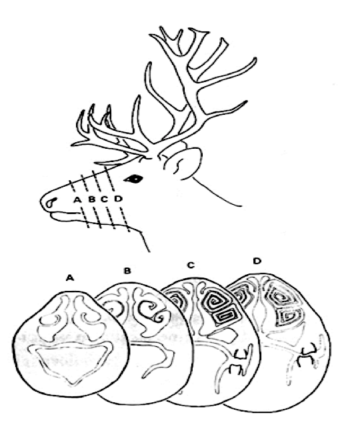
The reindeer nose has a very large internal surface area, which allows it to warm cold air in record time. How is this possible? What’s nature’s secret recipe? Illustration photo: Per Harald Olsen
Reindeer live in harsh conditions during the winter. In Svalbard and on the fells and mountains of mainland Norway, temperatures sometimes drop to 30-40 degrees Celsius below zero. Little food is to be found when snow covers the landscape, and reindeer have to chew cold snow to get water. So how do reindeer survive when it’s so very cold?
Their thick fur is a good insulator, but that isn’t the whole explanation. Reindeer also survive by releasing as little heat as possible to the environment through their nose – and by conserving as much water vapour as possible.
What is it with Rudolph’s nose?
Does Rudolph’s nasal structure explain why reindeer do so well in cold climates?
This hypothesis interested PhD student Elisa Magnanelli and her NTNU supervisors, Signe Kjelstrup and Øivind Wilhelmsen, who also is an adjunct professor and researcher at SINTEF Energy Research. Their disciplines are thermodynamics and mass and heat exchange. But why would engineers be curious about animal respiratory systems? That will soon become clear.
Reindeer on treadmills
Magnanelli and her supervisors work closely with scientists at UiT—The Arctic University of Norway in Tromsø. The Tromsø researchers have brought real reindeer into a climate chamber and had them walk on a treadmill to study their respiration – all in the service of science. Measurements show that reindeer have a fantastic ability to change the temperature of the air they inhale before it reaches the lungs, and vice versa. If the outside air temperature is 40 degrees C below zero, the temperature when the air reaches the reindeer’s lungs is about 38 degrees C.
That means the reindeer’s ingenious nasal structure can change the temperature of the air an incredible 70-80 degrees in less than one second. On exhaling, the reindeer cools its warm breath instantly, in order to conserve as much body heat as possible.

Professor Signe Kjelstrup and her colleagues have long been interested in nature’s approach to different energy-efficient systems. Tromsø researcher Arnoldus Schytte Blix suggested she look into how reindeer handle extreme cold. Photo: NTNU
In addition, the reindeer breathes out minimal moisture when it exhales – which is especially important when the access to water is only snow, and icy snow at that.
Huge inner nose surface
The powerful reindeer snout is made up of cartilage and bone, fleshy structure, mucous membranes and lots of blood vessels. Researchers at UiT have taken internal measurements of the nose and done CT scans of reindeer nose slices. In this way, the researchers were able to acquire cross-sectional images of the reindeer’s breathing organ in its entire length. The pictures show that the nose interior has an unusual and strange structure that resembles a seashell.
Researchers also measured the inner surface area, which turned out to be enormous. Enormous in what way? Think of the Norwegian coast. If you measure the actual length of the coast, including all the nooks and crannies, you will find that the coastline is enormously long. This is what the inner surface of the reindeer’s nose is like as well. The expansive inner surface provides plenty of space for exchanging heat and water vapour between the air and the nasal wall.
What is nature’s recipe?

The illustration shows cross-sections of a reindeer nose. It clearly shows the complex structure of the nose, which looks like the cross section of a seashell.
So the nose has this very large internal surface, converting cold air to warm air in record time. How is this possible? What is nature’s secret recipe? Rudolph’s incredible ability to warm the air and control its humidity is an exciting topic for the NTNU researchers, who study thermodynamics and heat exchange.
Professor Kjelstrup and her colleagues have spent years studying energy-efficient systems. She began to speculate about whether nature itself could teach us something about energy efficiency, and contacted the Tromsø researcher Arnoldus Schytte Blix, who told her about the reindeer research.
Mathematical reindeer nose
The researchers decided to create a mathematical model of a reindeer’s nose. Magnanelli was assigned the task. She obtained several vital measurements from other research groups, including the researchers in Tromsø. These measurements included the amount of air a reindeer inhales when it breathes, blood flow rates and temperatures in different parts of the nose and the moisture content in the reindeer’s breath. The data were used both to develop and to assess the accuracy of a computer program specially designed to simulate a reindeer’s nose.
Data noses in the lab
In addition to creating a data-simulated reindeer nose, the scientists created a computer program of a simplified cylinder-like data nose that served as a reference case.
The researchers conducted repeated experiments in both data noses, with surprising results.

The picture shows a cross-section of a reindeer nose, with its complex seashell involutions. The structure makes for a huge surface area, allowing it to warm and cool air as needed and conserve moisture. Photo: Mario Acquarone
One finding showed that Rudolph’s nose can mostly be explained by the well-known theoretical principle of constant entropy production. The term could confuse the most avid lay reader without a quick explanation– so stay with us: When you go ice skating, you use some of your energy to overcome the friction that occurs between the ice and the skates. The friction generates heat under the skate blades, and energy is used. This is an example of the second law of thermodynamics.
But no real process is one hundred per cent energy efficient. Some friction always exists, which dissipates as heat into the surroundings. If you live in Svalbard or on Norway’s frigid Røros plateau, it’s important to lose the least amount of energy into the surroundings. Reindeer have clearly figured this out.
An ingenious design
Magnanelli’s simulation experiments, carried out 1600 kilometres and 15 degrees of latitude from the reindeer’s northernmost stomping grounds, shows that their nose mostly works according to the principle of minimum energy loss. This energy dissipation in the form of friction is what scientists call entropy production. The brilliant reindeer nose ensures that entropy production is nearly always uniform. This means that the animal as a whole loses the least possible amount of energy into the environment when it breathes. The reindeer nose roughly follows the mathematical “constant entropy production” equation.

Elisa Magnanelli, a PhD candidate, discovered that the way the reindeer nose works roughly follows the mathematical equation “constant entropy production”. Photo: Maria Amelie
To explain why this is so beneficial, consider the skating example. To use the least amount of energy to get around an ice rink, it’s best to maintain a steady speed. The same is true of reindeer noses – they’re designed to have close to uniform entropy production.
The colder the weather, the more effective the nose
The second finding that surprised the researchers is that the colder the air, the more energy efficient a reindeer’s nose is compared to a nose without the seashell shape. At 30 degrees C below zero, the reindeer’s seashell-shaped nose works even better than it does at 10 degrees below zero.
Between the mathematical nose model and the close-to-constant entropy production finding, NTNU researchers are now better able to explain how a reindeer’s nose works. The cold air is drawn in through the nostrils, passing over the large inner surface area. This surface consists of nasal mucus, located outside the fleshy nose structure and with many small blood vessels. The warm blood instantly and continuously heats up the mucus, which in turn heats the air being inhaled.

Øivind Wilhelmsen is Professor II at NTNU and a scientist at SINTEF Energy Research. He is one of Elisa Magnanelli’s supervisors.
Reindeer need to retain the water or moisture exhaled from the lungs so they don’t need to eat snow. And this illustrates another brilliant feature of nature: Winter air is cold and dry. In order for the heated air not to be too dry when it reaches the lungs, a little moisture is emitted from the mucous membranes into the air when the reindeer inhales. When the air is exhaled, the mucous membranes recover the moisture, so the reindeer exhales dry and partially cooled air.
Nature-based design
There are many reasons why scientists and engineers are eager to understand how the reindeer’s nose works. Reindeer noses serve as excellent heat and vapour exchangers because of their complicated seashell-like shape.
In fact, it’s entirely possible that this newly acquired knowledge may one day come in handy when industrial designers need to create balanced ventilation systems for homes and cottages in extremely cold climates. It may also provide an important contribution in building net-zero homes in the Arctic when the time is right.
In fact, it would probably be a perfect project for Santa’s workshop at the North Pole.
Link to article: The Nasal Geometry of the Reindeer Gives Energy-Efficient Respiration.

